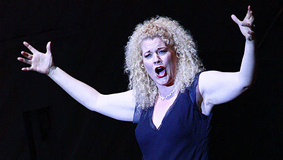| Opera Reviews | 26 April 2024 |
Chills and splendor with Bluebeardby Steve Cohen |
|
Bartók: Bluebeard's Castle |
|
|
In a conversation after the Saturday performance, the maestro disclosed that he’ll continue to perform operas in Philadelphia even while conducting regularly at the Met because the Philadelphia Orchestra has a singular quality, and also because he’s interested in different ways of presentation. Some operas, he says, will sound distinctly different with a large orchestra playing on the stage rather than in a pit. Such, indeed, was Bluebeard’s Castle. The piece was done at the Met in 2015 with Valery Gergiev conducting. In these Philadelphia Orchestra performances, Yannick positioned mezzo Michelle DeYoung to his left and bass-baritone John Relyea to his right. Intentionally, there was no scenery to distract from the confrontation between those two people. The characters sing to each other throughout this opera, but not together, which seems to illustrate how they cannot reach one another. Trumpets and trombones were placed in the organ loft above the stage and added their power to the organ’s at the height of the action. In this psychological drama, Bluebeard’s latest bride, Judith, coaxes him to open the locked doors inside his home. One by one, rooms are revealed filled with instruments of torture, armaments, gold, and flowers. Each is tone-painted with contrasting orchestral colors. A climax comes when the fifth door opens to reveal a magnificent sweep of beautiful vistas and the orchestra switches from the key of F sharp (containing six sharps) to the sunny C major. As the brass appeared above him at this point, Yannick raised a pulsating hand to signal that he wanted the maximum volume and projection. This is the one place in the drama where we feel something positive. Judith elsewhere sees beautiful jewels, then notices blood drops on them; then flowers which also are blood-stained. I always wonder what she originally saw in this man; she sings that she believes she can bring light to his world of darkness. Judith is discovering not just Bluebeard’s possessions but facets of his persona: boastful, defensive, mysterious, and occasionally passionate. They are accompanied by an orchestra that is, by turns, spooky, lyrical and dissonant. The librettist Béla Balázs said “I wanted to depict a modern soul in the primary colors of folk song.” Bartók recorded and notated hundreds of such songs from villages in Hungary and Romania, which influenced this composition. Another inescapable influence was Richard Strauss’s early tone poems, which Bartók admired — and his Elektra which premiered two years before Bartók’s opera. But Bluebeard’s Castle includes elements that Strauss never achieved, such as the shimmering arpeggios from winds, celesta, and harp when Judith opens the sixth door to reveal a lake of tears. Bluebeard sings the word “tears” nine times in that scene, preparing Judith for what she’ll see next. Then a virtual scream erupts from the orchestra just before Judith joins Bluebeard’s other wives behind the final door. Relyea revealed a voice that’s grown in depth and darkness in recent years and is ideal for the role. DeYoung has a warm low quality yet also proclaimed a terrific, long-held high C when her character saw that magical kingdom. For two scenes where Bartók specified the sound effect of wind, Nézet-Séguin used audio clips borrowed from the Met’s production. He said that next time he might copy an idea of James Levine’s and have his trombones blow air through their instruments. Bluebeard’s Castle is one hour long, so it needs another piece on the program. Nézet-Séguin started the concert with excerpts from Tchaikovsky’s Swan Lake ballet. Although you may see little in common between the two pieces, consider the fact that both were based on fairy-tale stories. Or perhaps that both compositions were icons of the Eugene Ormandy tenure with the Philadelphia Orchestra. Ormandy frequently led performances of Swan Lake and he recorded Bluebeard’s Castle (in English translation, with George London and Roslaind Elias) for Columbia Records in 1960 when few conductors would touch it. Yannick loves to associate himself with the history of this revered institution. His interpretation of the Tchaikovsky had the lushness, especially from the strings, that made this orchestra famous.
|
|
| Text © Steve Cohen |

 Yannick Nézet-Séguin, about to become the music director of the Metropolitan Opera, led a performance of Béla Bartók’s operatic horror story, Bluebeard’s Castle, with the Philadelphia Orchestra (and Met singers) for three weekend performances in Philadelphia plus a visit to Carnegie Hall.
Yannick Nézet-Séguin, about to become the music director of the Metropolitan Opera, led a performance of Béla Bartók’s operatic horror story, Bluebeard’s Castle, with the Philadelphia Orchestra (and Met singers) for three weekend performances in Philadelphia plus a visit to Carnegie Hall.





